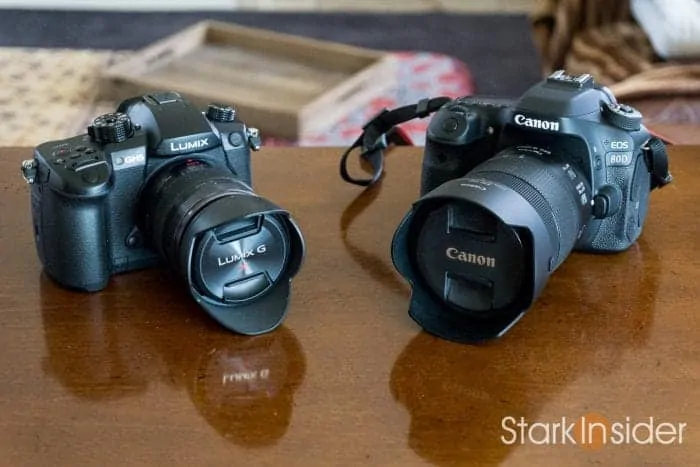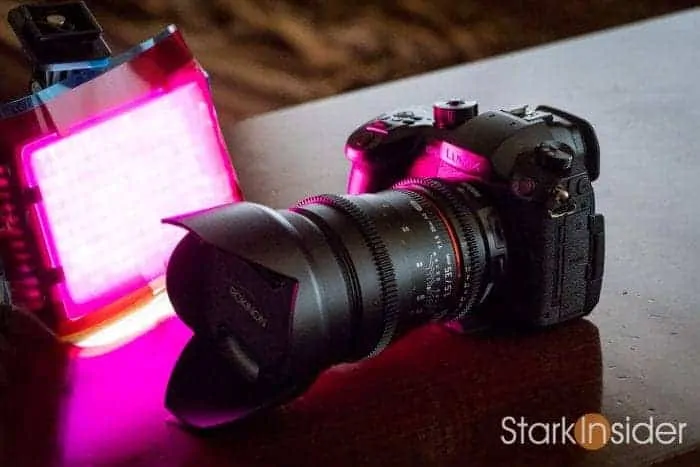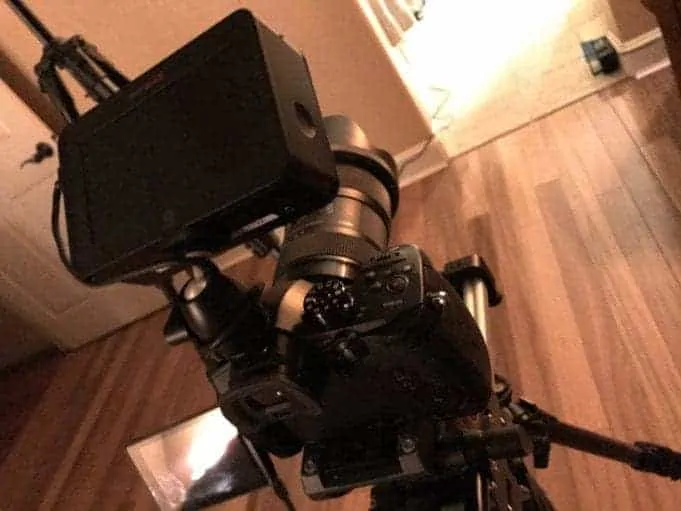Quite simply Panasonic’s new GH5 mirrorless camera blows my mind.
Cliche. True. But sometimes you just can’t help yourself.
I’ve been shooting video for about 10 years now for Stark Insider. Most of that time I’ve used a variety of Canon DSLR cameras (though I did start in the early days on a good old Canon Vixia camcorder… in SD!). So probably like many of you, I upgraded every few years or so as my budget allowed: from Rebel T2i to EOS 60D, then 70D (game-changer with its Dual Pixel auto focus system), and finally to the 80D. In 2015 we also began shooting some video segments on a Canon C100 Mark II Super 35 camera. That’s been very solid, and reliable, with a pretty image.

A lot of fuss was made in the filmmaking community with the GH4. I never used one — too bad as it seems that, sort of like the Canon 5D Mark II, would change everything, empowering aspiring filmmakers with a powerful tool at a reasonable price. But when the GH5 and its gargantuan specs were released (10-bit color! 2 SD card slots! VFR up to 180fps! And on! And …) I knew I wanted to at least give it a shot. After all, if things didn’t work out, I could fall back on the trusty 80D which had served us well for a few years.
I’ve shot at least one short film so far with the GH5 (see Crazy or Die below), and also we’ve used it on a few travel pieces which are being edited now (and the footage looks peachy). Safe to say I will be using the GH5 on a lot of projects moving forward. Sadly — oh the good times we’ve had — the 80D will likely end up being used primarily as a photo-only tool… a great one at that to be sure. But for video it’s all GH5 now.
So I thought I’d share 5 “lessons” — the good and the bad — I’ve learned so far when shooting video (I’m not a photographer) with the almost too-good-to-be-true mirrorless camera known as the Lumix GH5.
5 Lessons Learned Shooting Video on the Panasonic GH5
1. In-Body Image Stabilization (IBIS) is insanely good. And I mean absolutely insanely good.

The GH5 has IBIS which means it will stabilize the image automatically. This feature is especially handy for lenses that don’t have any type of stabilization built in. Many cinema lenses, for example, don’t and are completely manual. Without IBIS you’d need some sort of rig to stabilize a cine lens. With the GH5, as I’ve discovered using lenses by Rokinon and Sigma that don’t have stabilization, you get a very steady image… even handheld. This to me is ground-breaking. It means I can use high quality cine primes for handheld work, and no longer need to carry around a tripod or some sort of gimbal.
Other cameras have IBIS too. This isn’t new. Recently, on a trip to Paris and Iceland, I carried along a Sony Alpha a6500 mirrorless camera. A wonderful little thing, albeit with several shortcomings. Among them is battery life. But the biggest issue I saw was the footage. It was jello like. The a6500’s IBIS would warp the footage in an attempt to stabilize it (much like you might see when setting the “Warp Stabilizer” feature in Premiere Pro too aggressively). On the other hand, with the GH5 I don’t perceive it all. It may be there… but I can’t see it.
For the quality of its IBIS alone, I’d regard the GH5 as simply outstanding. That you get so much else is icing on the cake. Gushing, again. I know.
2. Dual SD card slots (Double Slot Function) let me sleep at night
It may sound pedestrian, but having 2 SD card slots is very welcome. My Canon C100 II has them — but that camera costs several thousand more than the GH5. I don’t recall a DSLR or mirrorless at this price point ($1,995 USD) having multiple slots. If you’re like me you don’t sleep well at night until you’ve backed up your footage at least three times, in multiple locations, including a fire-proof vault. We work hard to capture stuff, right? So it makes sense that we get it backed up so that earth can continue its proper rotation.
With the GH5 you can configure the dual SD card slots several ways.
One is to use them in serial fashion (“Relay Rec”), so that after card 1 fills up the camera automatically starts recording to card 2 — handy for those that shoot long events. For me, it’s all about serial recording (“Backup Rec”). In this mode the GH5 simultaneously records video to both card 1 and 2. That way I’ve got an immediate backup with me. Peace of mind. If we break for lunch I can pull out a card, put it in my wallet, and know that we won’t loose everything if by change the camera gets stolen. (Note: you can also chose a third mode “Allocation Rec” which can record photos on one card and videos on the other… cool!)
Not the sexist thing in the world, but having dual SD card slots should become the norm, especially for pro-level gear. The GH5 thankfully has them, and I wouldn’t be surprised to see others in this market segment follow Panasonic’s lead.
3. That beautiful image!

I didn’t expect it all. It’s going to be too digital, I thought. For me, film is the thing, and anything I can do (FilmConvert, Lumetri) to make my stuff look less video-ish and more film-ish is a priority. Ultra-sharp, super “crisp”… nah, not really my thing. Given what I knew, or thought I knew, about the GH line of cameras, with the MFT (Micro Four Thirds) sensor and in-camera noise reduction and sharpening, I expected to see an image that was harsh and, for lack of a better word, digital.
Boy was I wrong.
Last year I shot a bunch of footage in Sonoma under gorgeous redwood trees. I used a Blackmagic Micro Cinema Camera in film mode. It looked gobmasckingly good, especially given its $995 price point (though you need to add an external monitor). Comparatively, in my non-scientific tests which involves me eyeballing footage on my 4K studio monitors, I’d say the GH5 comes very, very close. Highlights don’t look harsh, there’s pretty color rendition, and the overall image looks somewhat organic. I’d say the Blackmagic, and RED for sure, beat the GH5 on dynamic range. But using the GH5 is so convenient, and brings so many benefits (ergonomics, long battery life, compact size, aforementioned IBIS) that it far outweighs the hassles of the Blackmagic camera.
4. VFR / slow motion

You can shoot up to 180fps on the GH5. While you’ll need to shoot the highest VFR in HD, you can shoot at 4K up to 60fps — an ideal setting for a lot of commercial work, music videos, fashion films, etc.
I’m not typically a slo-mo kind of guy, instead preferring to shoot mostly doc style. But I did recently take the GH5 to a shoot in Vancouver, Canada and shot a night-time street scene in 4K/60fps. Back at the edit bay, I found the footage to be, again gushing, gorgeous. Sure, at 60fps you “only” get 8-bit internal files (you need an external recorder to get 10-bit/4K/60). Good enough for me, especially since it enabled me to be a stealthy little bugger on Robson Street, shooting stuff without drawing attention.
VFR on my 80D? Nope.
C100 Mark II? Nope.
GH5? Yep.
I’ve assigned VFR to the custom modes (C1, C2) on the wheel on top right of the GH5, and can quickly switch from normal frame rate (23.98 fps) to slow motion. Much like a RED, the camera does everything automatically for you, so you needn’t worry about the projects base rate, or shutter speed (leave it at 180 degrees most of the time). Easy stuff.
VFR. GH5. Yes, I believe.
SHOT ON PANASONIC GH5: Crazy or Die short film
Shot on Panasonic GH5. Sigma 18-35mm. Rokinon 35mm. A wife. A wig. A beer.
5. The not-so-good: record indicator lag, DISP button placement, poor AF
But there are some minor niggles. I’d still give the GH5 a perfect 5/5 in a proper review, but there are some things where they kind of didn’t get it completely right.
Record indicator lag — when you push record, there’s a slight delay before the indicator appears on the LCD. And it blinks too slowly. Because of that, often I find myself thinking I didn’t hit record even though I actually did so I press the button a second time, which promptly stops the recording. I’ve missed shots because of this. I’m hoping Panasonic can make the record indicator respond faster and blink faster, or even just be steady state red indicator. Hopefully this fix will come in a firmware update (Panasonic has several planned that add even more features to the GH5).
DISP button placement is weird — there’s a “DISP” button on the right side of the camera body at the rear. But it’s right near your hand and fingers, so it gets accidentally pressed a lot. Fortunately, it merely cycles through the display modes on the LCD (varying the type of information shown) so it’s not destructive. But it’s a head-scratcher as to why Panasonic decided to put in a place that would be so prone to accidental presses.
Auto-focus is not great — if you’re a Vlogger and want reliable AF get a Canon EOS 70D or 80D. End of story. AF on those cameras is the best on the market. You can tap an object, and Canon’s DPAF will track it with high accuracy and reliability. The GH5? No, don’t expect anything close. It has AF, yes, but it’s not groundbreaking, and average at best. For me, it’s not a big deal as I use manual almost all the time (focus peaking and punch-in on the GH5 work extremely well for achieving critical focus). Those rare times I need AF I use the 80D.
Conclusion: It’s just a tool, but a great one at that

If you’re into videography or filmmaking and can afford a $2,000 camera body, I’d say short-list the GH5. In fact, just go for it. Get a metabones, use Canon EF lenses, such as the extraordinary Sigma 18-35mm and that glorious IBIS and 10-bit color, and you’re good to go.
Panasonic GH5 by Clint Stark
Those with smaller budgets needn’t fret as you can get exceptional results too from cameras such as the venerable Rebel T2i (with green — err, magic — lantern firmware) and even, of course, the older GH4 which can be found substantially discounted. Or just use your smartphone for now. Think up an interesting narrative or shoot something surreal. Or maybe find an interesting character in your neighborhood and tell their story.
In the end, cameras are just tools, and it’s up to us to do everything else.
However, if I had to use only one camera body on a shoot, it would be the GH5. Every time… this coming from a long-time Canon DSLR shooter.


